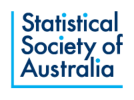Farewell to William Dunsmuir after 25 years at UNSW
On 6th June the New South Wales branch was very pleased to be part of a milestone event held at the School of Mathematics and Statistics, University of New South Wales (UNSW). The event was to celebrate the career of Professor William Dunsmuir, who just retired after around 25 years at UNSW. William has also been a great contributor to the society and served as national president during the late 2000s.
About 100 people attended a drinks and canapes party,followed by a testimonial event. Jake Olivier was the compere and pointed out that William spent most of Jake's eleven years at UNSW "about to retire". Head of school, Bruce Henry, spoke next and summarised William's contributions to UNSW.
Next up was Doug Shaw who told everyone about how William led the response to the Melbourne 2008 debacle, when a conference company ran off with our registration fees and left us to pay the conference bills. Doug pointed out that after this difficult period the branches more congenial to each other.
Then Sue Wilson (UNSW and Australian National University) headed to the podium and delivered a short talk titled "An Irregular 45 Year Time Series". Sue told us that she and William first met at the Australian National University in 1974 when they were PhD students together. Some interesting photos of prominent Australian statisticians when they had a lot more hair than today were projected.
Following Sue was Feng Chen, who has been a departmental colleague with William at UNSW for the last several years. Feng talked about their joint work on generalised autoregressive conditional heteroscedastic models and sequential Monte Carlo algorithms.
William's oldest friend at the event was David Scott of the University of Auckland, New Zealand, and he was one of the event's special guests. David told everyone about having known William since 1972 and how they hung out together at the La Trobe University campus in the early seventies getting very excited about "A Course in Probability Theory" by Kai Lai Chung.
After a few more facial hair photographs David talked about their time together at the Siromath consulting company in the mid-1980s and then becoming colleagues at Bond University in the late 1980s.
Towards the end of his presentation he shared some pictures of he and William on the Queen Charlotte Sound walk in New Zealand.
Kylie-Anne Richards was the last of William's PhD students and she delivered a presentation titled "The Impact and Marks of Mentors". She expressed he gratitude for William helping her to achieve her dream of become an academic after starting a family. Hawke's self-exciting point processes and limit order book events were also discussed.
The principal speaker was Richard Davis, who is chair of the Department of Statistics at Columbia University in New York City.
Richard's talk, titled "William and Me", described his close friendship and research collaborations over a period of 40 years. Richard and William first met as assistant professors at Massachusetts
Institute of Technology in the late 1970s. After William returned to Australia in 1980 they did not see much of each other for another decade. But in 1990, a time series workshop in Minnesota reunited them and led to a very successful collaborative partnership that saw them unlocking the mysteries of the moving average unit root problem followed, obviously, by GLARMA(0,1).
As is known in time series circles, this is a generalized linear autoregressive moving average process of autoregressive order 0 and moving average order 1. Later they worked on least absolute deviations, and have been continually publishing together since around 1995. Richard's bottom line was the great intuition that William brought to their research problems.
The pre-dinner part of the Dunsmuirfest finished with William getting up and giving us a short talk tilted "Large sample theory for detecting the impact of marks in Hawkes self-exciting point processes". He told us that out of his career achievements, he gained the most pleasure from proving large sample theorems for time series. He presented a recent central limit theorem-type result and explained the steps. After the technical part, heclosed the event with some words of thanks. UNSW, the Statistical Society of Australia and family and friends were mentioned first.
He pointed out that he had worked with hundreds of people and taught thousands of students over the course of his career. Then he publicly thanked particular people for playing extra-special roles in his career and life: Bruce Brown, Niels Becker, David Scott, Pat Moran, Ted Hannan, Sue Wilson, Herman Chernoff, Doug Shaw, Robert Kohn, Richard and Cathy Tweedie, Richard and Patti Davis, and his wife, Barbara Blanche with whom he celebrates 35 years of marriage in July 2019.
Matt Wand
University of Technology Sydney
